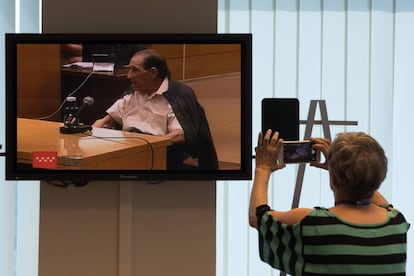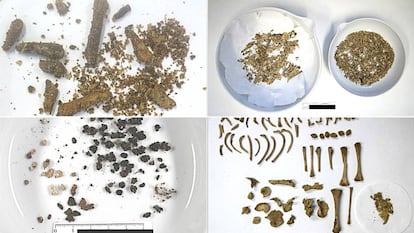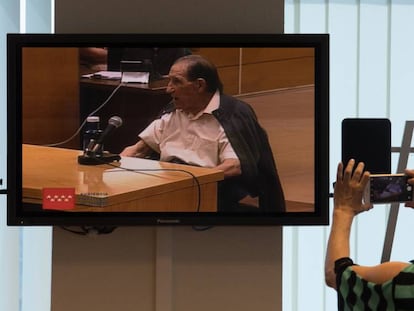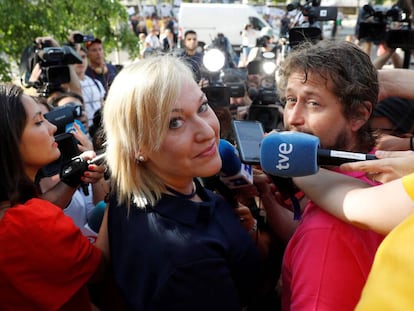DNA tests cast doubt on Spain’s “stolen baby” network
In 81 results, the remains of newborns suspected of being given away under the Franco regime genetically matched their parents

On June 6, 1969, Doctor Eduardo Vela gave a newborn baby girl to a woman who had not given birth to her “outside of legal channels.” The woman, aged 46 at the time, was then registered as the biological mother “without proof of consent or even knowledge of the newborn’s real parents, whose identity is not recorded anywhere.”
This was the conclusion of the Madrid High Court in its historic first ruling on a high-profile “stolen baby” case. The adoptive mother, Inés Pérez, maintained during the trial that she had not paid anything for the baby girl, and that she was told the child had been given up by her mother because she was the product of an extramarital affair.
It is impossible to prove what really happened, because the San Ramón Clinic in Madrid, where the girl was born, shut down in 1982 and no birth records have been found. Dr Vela, 86, said in the trial that he did not remember anything.

Victims associations have estimated that up to 300,000 children were stolen during the dictatorship of Francisco Franco by a network of nuns and doctors who took babies from poor families or single mothers and gave them to wealthy parents unable to conceive. In 2012, the public prosecutor, who received a collective complaint from 250 families, summed up the modus operandi of the operation as “informing the mother and the family that the newborn had died, and offering them to let the hospital take care of the remains. The minor was then delivered to other people.”
If this were the case, the graves of these newborns should be empty. Since 2010, Spain’s public prosecutor has opened 2,100 legal investigations into alleged cases of stolen babies, but most have been shelved for lack of evidence or because, after 40 years, there are no hospital records or any living witnesses. However, 522 cases have reached the courts and in 120 of them, prosecutors and judges have ordered the graves exhumed to see whether they were empty. When bones were found, they were tested by the National Institute of Toxicology and Forensic Science (INTCF). According to an INTCF report, released in 2017 ahead of a visit from an EU delegation to Spain to investigate the alleged network, the DNA tests showed that none of these babies had been stolen.
We are not saying that no child was stolen, but the cases we have seen up to now have been otherwise
Biologist Antonio Alonso
“We do not know of any case where it has been possible to confirm that the baby was stolen. What we have seen, instead, is that those parents were told the truth: the baby had indeed died,” says biologist Antonio Alonso, one of the top experts in forensic genetics in Spain. His team was able to rescue bone remains in 117 of the 120 exhumations – 97% of the cases. In two cases, there were no bones left but the team was able to use hair samples, hospital cloth and the dead insects that had eaten the bodies.
Testing for DNA was extremely difficult given the bodies’ state of decay. Out of the 90 newborns who were positively identified, 81 matched with their parents – in other words, 90% of the suspected stolen babies were not stolen. In the remaining cases, there are doubts as to whether the remains were the right ones – a common problem in mass graves. According to Alonso, decades ago, newborns who were not baptized used to be buried without a tombstone in different rows and on different levels. “The circumstances of the burials make analysis very difficult,” he explains.

The report by INTCF does not support the notion that there was an illegal network that stole newborns, but rather that there was “understandable uncertainty” from many parents over whether their child really died, says Alonso, noting that treatment by hospital staff at the time could be cold and impersonal. In 1979, the newborn mortality rate was more than nine children for every thousand births. Many parents preferred to think that their child was stolen rather than dead. As one parent explained at an exhumation in Málaga in 2012: “I didn’t want the remains to be those of my child. That would mean that he is still alive.”
“There are parents who don’t believe our DNA analysis. They believe it’s a state conspiracy. They doubt our work and our honesty,” says Alonso, who has helped identify the victims of the Madrid train bombings of March 2004, as well as victims of the Spanish Civil War; he even participated in a project to find the remains of Spanish writer Miguel de Cervantes.
Rafael Bañón, director of the Legal Medicine Institute in Murcia, participated in four exhumations in Cartagena, Beniel, Alcantarilla and Fortuna, and he agrees with Alonso. “We found what we were expecting: the children of the claimants,” he says. “I don’t think there was a systematic theft of newborns in Spain, but rather a problem of irregular adoptions.”

A police investigation cited at the trial against doctor Vela reported the existence of “a women’s shelter for single mothers, Villa Teresita, which cared for the young women during their pregnancy on the understanding that they would give their children up for adoption.”
“What sometimes happened was that a mother who could not care for a child gave it up for adoption, and the child was registered as the biological child of the other mother who did not give birth,” explains the lawyer Carmen de Troya, the coordinator of an information service for victims of the alleged stolen baby network.
Many parents preferred to think that their child was stolen rather than dead
Her office, which works under the Justice Ministry, has assisted 770 people since it opened in 2013, and created a list of DNA profiles to help fill in the missing pieces of the puzzle. The database is managed by INTCF and contains 563 profiles. An overwhelming number of these (74%) are parents looking for their children, while only 13% are of children in search of their biological parents. The rest are brothers and sisters. “We have not found any match in any of the profiles,” says De Troya.
“Many of the adopted children looking for their biological parents were abandoned at inclusas [charities where babies were left anonymously]. We are not saying that no child was ever stolen, but the cases we have seen up to now have been otherwise,” explains Alonso. “Perhaps we are investigating the wrong modus operandi.”

María Bueno is convinced that her daughter was stolen. She gave birth at the Municipal Hospital in La Línea de la Concepción, in the south of Spain. Her daughter, according to the nuns, died at birth. “Judicial documents say we have suffered mass psychosis because of the media. But I have a death certificate for my daughter dated December 24, 1981 and another one that says she was not registered in the cemetery,” says Bueno, the general coordinator of the International Platform of Victims of Forced Child Disappearances Te Estamos Buscando (We Are Looking For You). Her organization is made up of more than a dozen associations but she admits she does not know where the figure of 300,000 stolen children came from. “There could be 300,000, 400,000 or 250,000, but this is not the crux of the issue,” she says. Under Franco, “children were stolen en masse.”
“What the neonatologists have done in this country is to save lives, not rob children,” argues Francisco Etxeberria, professor of Legal and Forensic Medicine at the University of the Basque Country. Etxeberria believes there was a “collective psychosis” where many parents believed their own children had been stolen because of media coverage of the issue. Filed complaints about stolen babies rose after graves were opened in the Basque Country and reportedly nothing was found inside. “They said the coffins were empty, but they weren’t” says Etxeberrria.
There is a scientific reason why some graves might appear empty, as evidenced by a 2012 report from the INTF, commissioned by the Basque regional government. The authors, Amparo Jiménez and Teresa Cabellos, looked at 16 exhumations and found that “the grade of skeletal health and the degradation of the remains varied greatly, from a newborn buried in 1972 that was almost entirely preserved through a process of mummification, to an individual from a similar date that to the naked eye had no bone remains.” Etxeberria, who has worked on more than 500 mass graves from the Spanish Civil War, insists that “remains degrade and can become almost negligible residue.”
In 2012, the Basque premier at the time, Patxi López, maintained that children were stolen for profit. “It had to be very well organized between doctors, hospitals and cemeteries,” he said in an interview with the public Basque television channel. “I think that there was obviously a network and it has to be investigated in depth to work out who was responsible and hold them to account.” Months later, following an an investigation by the regional police force, the then-chief regional prosecutor, Juan Calparsoro, announced that there was “not even prima facie evidence” that any babies had been stolen.
English version by Melissa Kitson.


